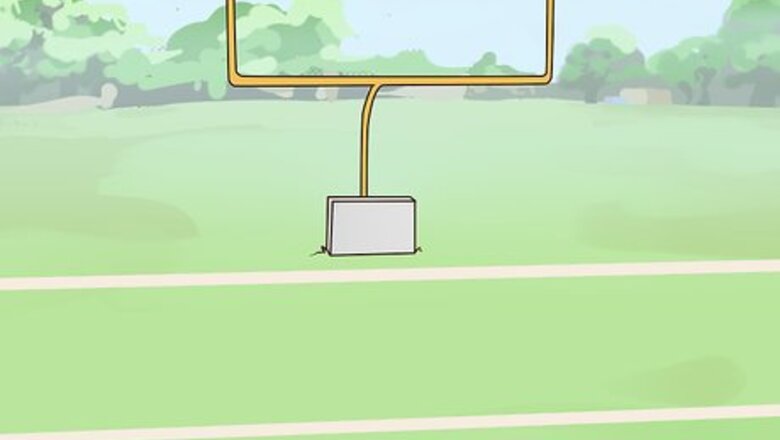
views
Setting up the Kick
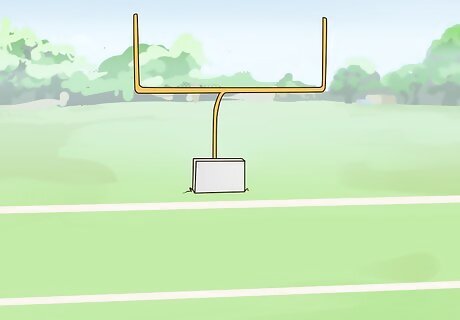
Find an appropriate place to practice. Naturally, a football field will make the best place to drill your kicking technique. If you don’t have access to a field, you can make do with just about any open area, like a public park or even your own backyard, as long as it’s spacious enough to offer you the room you need. Many schools, churches, and recreation centers make their football fields open for community use. Just be sure to ask an employee if it’s alright for you to practice on the field before you get your session underway. Being on a field will give you a sense of what it’s like to kick in an actual game and allow you to use the yard lines as a helpful visual reference.
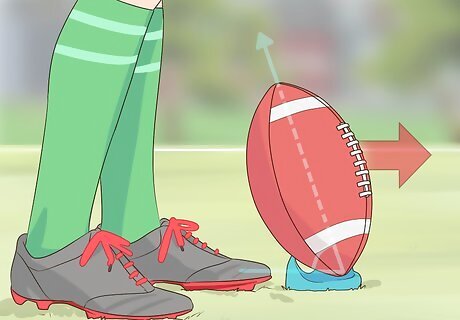
Stand the ball on a tee. A tee is a small device used to hold the oblong football upright until the kicker makes contact. When you place the ball on the tee, make sure the laces are pointed away from you and toward your intended target. The upper end of the ball should lean toward you just slightly—this will help you create lift to send the ball higher. It’s easier to learn proper technique kicking from a tee than from the ground when you’re first starting out. If you don’t have a tee, have a friend hold the ball with the tip of their finger and let go at the moment of impact.
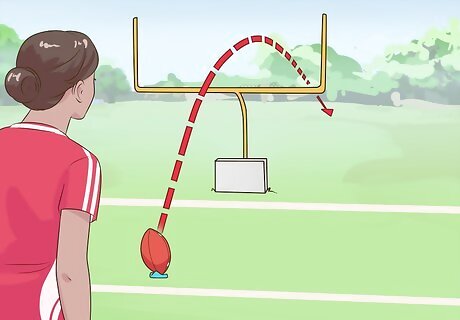
Visualize the ball’s path. Before you start swinging wildly at the ball, concentrate on where you want it to end up. The best way to do this is to choose a target (for example, the center of the crossbar on the goal or a distant object like a fence post) and square your body to it. Imagine the ball leaving your foot and sailing directly toward the target in a straight line. Creative visualization isn’t just good for your confidence—it can actually improve your hand-eye coordination.
Approaching the Football
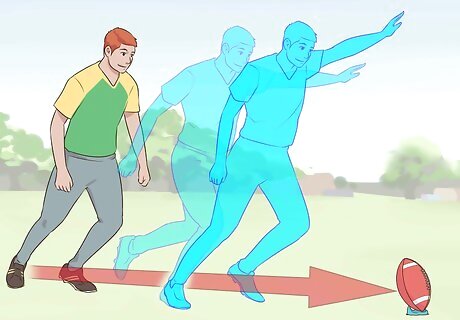
Begin your approach. Take a few trotting steps toward the ball from a comfortable distance. It’s best to run in a slight curve, so that you’re coming from behind and just off to one side. Keep your head lowered and your eyes on the ball the whole time. There’s no single best number of steps to take before the kick. Play around with different run-ups to discover which one works best for you. Field goals usually require a shorter approach because the opposing team will be attempting to block the kick once the play starts.
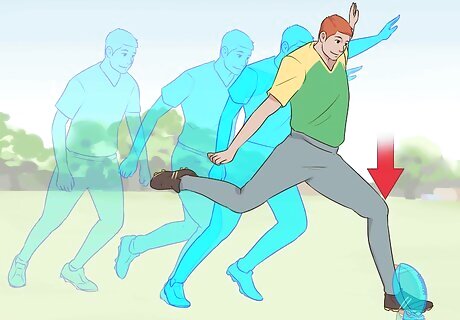
Plant your non-kicking leg. Turn your supporting foot outward and root it to the ground. This will provide you with a solid base and help you generate more force. As you prepare for the kick, keep your knee slightly bent to stabilize your lower body and core. If your support leg is too far away from the ball, you may lose power or throw yourself off balance. If it's too close, you run the risk of clipping it with your kicking leg. Avoid shifting, pivoting, lifting your supporting foot. Once it's down, it shouldn't leave the ground until you've completed the kick.
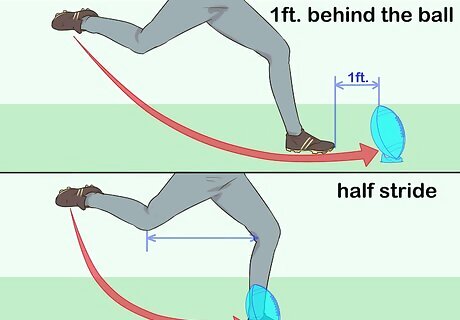
Find a comfortable range. Some kickers prefer to be about a foot behind the ball at the moment of contact, while others do better when they hang back a half stride or longer. Try out both methods and go with the one that feels most natural. Then, reset and continue practicing your approach, making an effort to end up in just the right position each time. Figure out what starting stance is required to put you in proper kicking position. For example, if you're right-handed and feel most comfortable taking about five steps, you'll need to start with your right leg forward so that you can plant your left beside the ball when you're ready to kick. The amount of distance you leave between yourself and the ball will mostly depend on your height. Keep in mind that your kicking leg should be fully extended and locked when it contacts the ball. This may play a part in determining your posture during the kick.
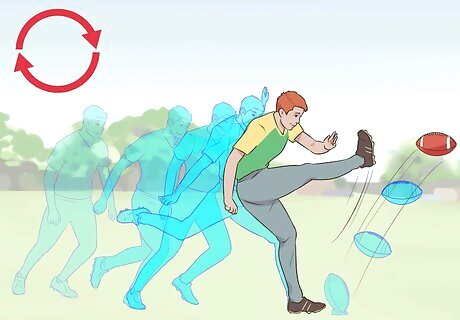
Develop a consistent approach. Once you start to get the hang of your run-up, remember how it feels and make an effort to do it the same way every time. The best kickers go through the exact same motions over and over again until they becomes second nature. Spend your first full session practicing without the ball to commit your approach to muscle memory.
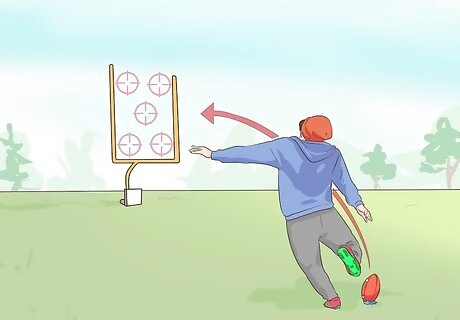
Practice variations once you're comfortable. Don't get in the habit of always kicking toward the same goal post—switch up your target, number of steps and angle of approach. Kicking from different distances and positions on the field will force you out of your comfort zone and give you some valuable practice aiming and controlling the ball. Try alternating between a long, leisurely run-up, taking as much time as you need, and a quicker approach for kicking field goals. Make sure you've got a good grasp on the basic technique before you start adding complicated variations.
Kicking with Proper Technique
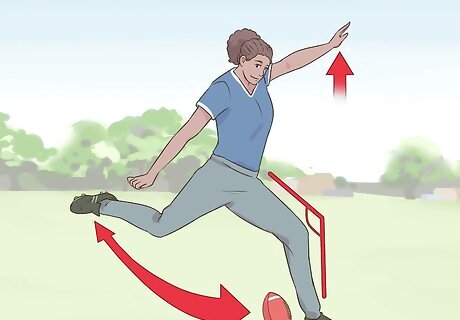
Wind up your kicking leg. Once you’re within range and your support leg is firmly planted, draw your leg back quickly, knee bent, so that it trails behind your body. At the same time, raise your arms and hold them out to your sides to help maintain your balance. Don’t try to pull your leg back too far. As with the rest of your kick, what feels most natural will also usually be most effective.
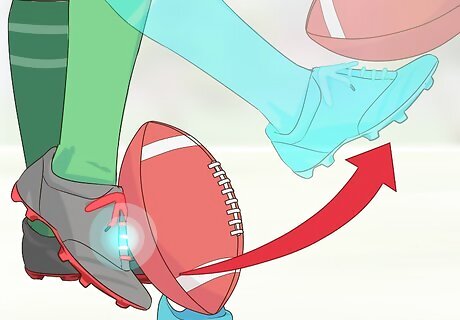
Strike the ball with the top of your foot. Specifically, your point of contact should be the broad part of your instep just in front of your shoelaces. Aim to hit the ball about one third of the way up from the bottom. As the ball leaves the tee, lift with your toe to give it some extra height. Channel the momentum from the last step of your run-up and swing your leg hard. Some kickers prefer to kick with their toe or the front of their foot. This is mostly a matter of preference. Do what feels most comfortable and gives you the best results.
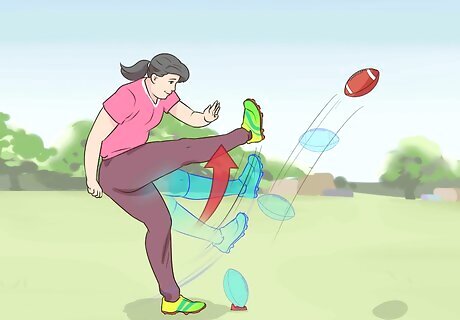
Follow through. Continue swinging your leg forward and up in the direction of your target. Keep your knee and ankle fully extended until the ball has left your foot. For maximum height and distance, the follow through is the single most important part of the kick, especially during the kickoff or a defensive field goal when you have a lot of ground to cover. Try not to let your leg cross your body. When you do this, you end up slicing the ball at an angle. If you find yourself spinning out of the kick, it means your kicking leg is looping around on the follow through. Make an effort to keep your leg under your hips and shoulders from the time you pick it up to the time you set it back down.
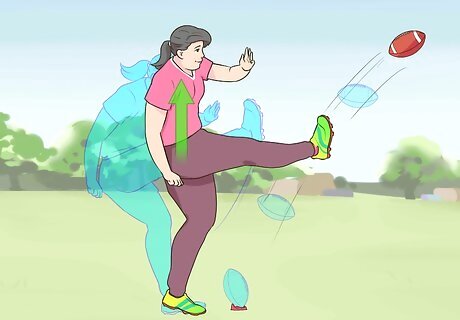
Keep your upper body straight. Your torso should stay vertical throughout the entire kick, with your arms held out to your sides for balance. If your shoulders are too far forward or leaning in either direction, there’s a much higher chance that the ball will veer to the side or fly low. Proper alignment is essential for building accuracy. A “taller” body position will allow you to dig into the ball without neutralizing the force you’ve built up. Most of the kicking technique, including the follow through, should be carried out by the lower body. Your upper body is just there to provide stability and control.
Improving Your Skills
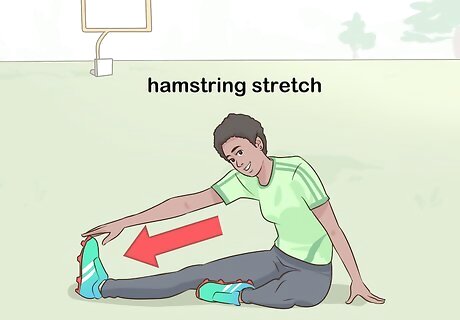
Stretch before every practice. Taking a few minutes to limber up relaxes your muscles and prepares them for the demands of an intense session. For best results, emphasize dynamic stretches like leg swings, hip rotations, and reaches lunges that mimic the kind of movements you’ll be performing while kicking. Pay special attention to each part of your leg that will be used during the kick, including the glutes, hips, hamstrings, quadriceps, and calves. Without proper flexibility, forceful, repetitive movements like kicking a football can eventually lead to muscular strain or injury.
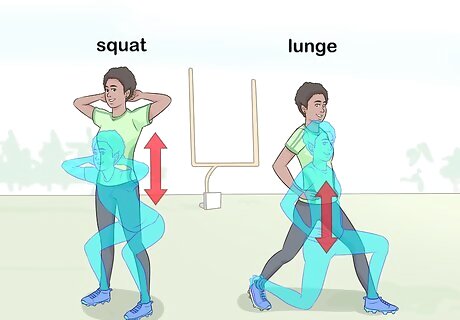
Strengthen your legs. Exercises like squats, lunges, are among the most effective for building valuable muscular strength and stability. Accessory movements like weighted leg extensions can also be quite helpful, as they translate directly to the follow through portion of the kick. To maximize the benefit of each exercise, make sure you work through a full range of motion in a controlled manner. Since power is more important for a kicker than stamina, keep the number of reps low (between 3-5) and focus on moving explosively. When bodyweight exercises begin to feel too easy, you can gradually add resistance in the form of free weights, machines, and bands to continue making progress.
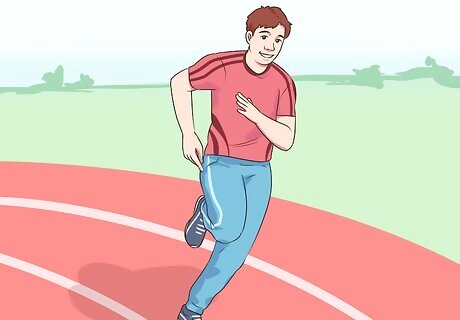
Run sprints to build speed. Incorporating short-distance sprints or back-and-forth "suicide" drills into your routine is a good way to condition your legs and ensure that they’ll be an asset on the field. If you’re running on a track, try sprinting the straightaways and walking the curves to give yourself a chance to catch your breath. Sprinting can be pretty intense, so be sure to take a few minutes to recover between each heat. Wait until after you practice kicking to complete your run. Otherwise, you’ll tire yourself out, which can cause you to develop bad form. Success as a kicker also depends on being fast and springy. While linebackers may have the strongest legs on the football field, kickers need to have the quickest.
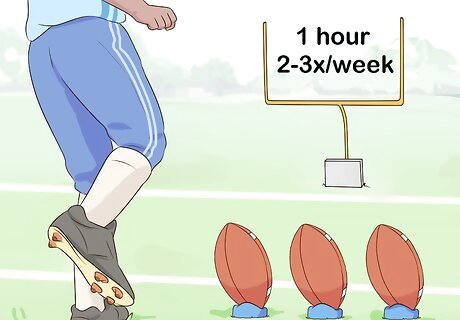
Practice frequently. Simply put, the more you practice, the better you’ll get. In addition to your strength and conditioning regimen, try to get out and fine-tune your kicking technique at least 2-3 times a week for about an hour per session. With a little dedication and a lot of hard work, you’ll begin to see an improvement in no time. Train hard, but don’t forget to have fun! After all, what else are sports about?















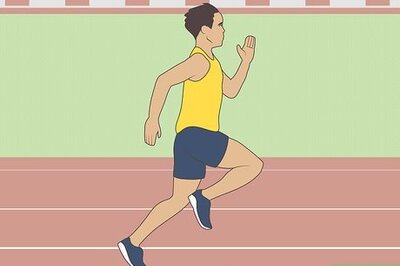



Comments
0 comment